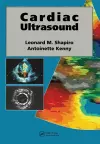
Cardiac Ultrasound
Leonard Shapiro - Paperback
£48.99
Leonard Shapiro has a keen interest in Anatomy Education and has developed a number of art-derived exercises to address and improve students’ three-dimensional (3D) spatial awareness and observation ability. His courses and online workshops are in collaboration with lecturers who are actively engaged in improving education methodology in anatomy. These are offered to medical students and lecturers in South Africa and abroad. Leonard has developed a multi-sensory observation method that crucially employs the sense of touch (haptics) coupled with the simultaneous act of drawing. It is called the Haptico-visual observation and drawing (HVOD) method.
In anatomy education, the benefits of observing using the HVOD method includes the enhanced observation of the 3D form of anatomical parts, the cognitive memorization of anatomical parts as a 3D 'mental picture', improved spatial orientation within the volume of anatomical parts and an ability to draw. Leonard contributes to the anatomy education discourse by presenting at anatomy conferences as well as via publications and articles. Leonard graduated in BSocSc and in BA Fine Art (Hons) from the University of Cape Town, South Africa.
Paul M. Rea - Paul is Professor of Digital and Anatomical Education at the University of Glasgow. He is Director of Innovation, Engagement and Enterprise within the School of Medicine, Dentistry and Nursing. He is also a Senate Assessor for Student Conduct, Council Member on Senate and coordinates the day-to-day running of the Body Donor Program and is a Licensed Teacher of Anatomy, licensed by the Scottish Parliament.
He is qualified with a medical degree (MBChB), a MSc (by research) in craniofacial anatomy/surgery, a PhD in neuroscience, the Diploma in Forensic Medical Science (DipFMS), and an MEd with Merit (Learning and Teaching in Higher Education). He is a Senior Fellow of the Higher Education Academy, professional member of the Institute of Medical Illustrators (MIMI) and a registered medical illustrator with the Academy for Healthcare Science.
Paul has published widely and presented at many national and international meetings, including invited talks. He has been the lead Editor for Biomedical Visualisation over 11 published volumes and is the founding editor for this book series. This has resulted in almost 70,000 downloads across these volumes, with contributions from over 300 different authors, across approximately 100 institutions from 16 countries across the globe. He sits on the Executive Editorial Committee for the Journal of Visual Communication in Medicine, is Associate Editor for the European Journal of Anatomy and has reviewed for 25 different journals/publishers. He is the Public Engagement and Outreach lead for anatomy coordinating collaborative projects with the Glasgow Science Centre, NHS and Royal College of Physicians and Surgeons of Glasgow. Paul is also a STEM ambassador and has visited numerous schools to undertake outreach work.His research involves a long-standing strategic partnership with the School of Simulation and Visualisation The Glasgow School of Art. This has led to multi-million pound investment in creating world leading 3D digital datasets to be used in undergraduate and postgraduate teaching to enhance learning and assessment. This successful collaboration resulted in the creation of the worlds first taught MSc Medical Visualisation and Human Anatomy combining anatomy and digital technologies. The Institute of Medical Illustrators also accredits it. It has created college-wide, industry, multi-institutional and NHS research linked projects for students. Paul is the Programme Director for this degree.